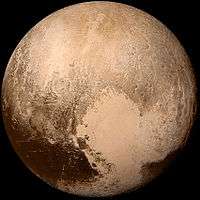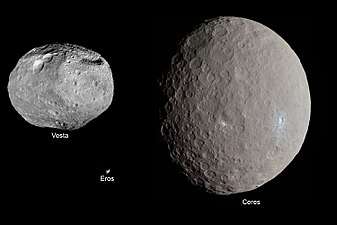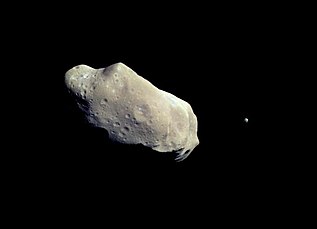ZhengHe (spacecraft)
ZhengHe is a proposed asteroid sample-return and comet exploration mission by China.
| Mission type | Asteroid sample return Comet orbiter/lander |
|---|---|
| Operator | CNSA |
| Mission duration | 10 years (planned) |
| Spacecraft properties | |
| Manufacturer | CAST |
| Start of mission | |
| Launch date | 2024 |
| Rocket | Long March 3B[1] |
| Launch site | Xichang[2] |
| Contractor | CASC |
| 2016 HO3 orbiter | |
| Sample mass | 0.2–1.0 kg (0.4–2.2 lb) |
| 133P/Elst–Pizarro orbiter | |
| Orbital insertion | 2032[3] |
Overview
Planned for launch around 2024, ZhengHe will use solar electric propulsion to explore the near-Earth asteroid 2016 HO3 and the main-belt comet 133P/Elst–Pizarro.[4][5] The spacecraft will rendezvous with 2016 HO3 and conduct remote sensing observations in orbit, before landing on the asteroid to collect a sample of up to 1 kg (2.2 lb) of regolith.[1] A nano-orbiter and nano-lander will be deployed to conduct remote sensing and sampling observations, and explosives will be used to expose potential subsurface volatiles for detection.[2] ZhengHe will then return to Earth to drop off a return capsule containing the sample and conduct a gravity assist maneuver to propel the spacecraft toward Mars, where a second gravity assist will be performed to direct it to 133P/Elst–Pizarro.[6] A flyby of an unnamed asteroid may also be attempted en route to 133P/Elst–Pizarro.[2] Remote sensing and in-situ measurements will be conducted at 133P/Elst–Pizarro for at least one year.[1]
History
In 2018, a deep space exploration roadmap covering the 2020–2030 timeframe was proposed by researchers at the Chinese Academy of Sciences,[7] which included an asteroid exploration mission planned for launch around 2022 or 2024.[8][9] In spring 2019, after a design study for the mission was carried out by the Chinese Academy of Space Technology (CAST), the CNSA began soliciting international proposals for scientific instruments to be carried on ZhengHe.[1][4][6]
Instruments
ZhengHe will incorporate several types of instruments, including wide/narrow angle multispectral and color cameras, a thermal emission spectrometer, a visible/near-infrared imaging spectrometer, a mass spectrometer, a magnetometer, and a charged/neutral particle and dust analyzer.[1][6] International contributions to these payloads are being encouraged.
The United Kingdom is considering a proposal for a penetrator to deliver a mass spectrometer to probe the subsurface ice of 133P/Elst–Pizarro.[3]
References
- Zhang, Xiaojing; Huang, Jiangchuan; Wang, Tong; Huo, Zhuoxi (18–22 March 2019). ZhengHe – A Mission to a Near-Earth Asteroid and a Main Belt Comet (PDF). 50th Lunar and Planetary Science Conference. Retrieved 4 June 2019.
- Jones, Andrew (5 August 2020). "China is moving ahead with lunar south pole and near-Earth asteroid missions". SpaceNews. Retrieved 5 August 2020.
- Snodgrass, Colin (October 2018). "Exploring the next frontier: the Main Belt Comets – Chinese MBC mission" (PDF). University of Edinburgh. p. 20. Retrieved 4 June 2019.
- Gibney, Elizabeth (30 April 2019). "China plans mission to Earth's pet asteroid". Nature. doi:10.1038/d41586-019-01390-5. Retrieved 4 June 2019.
- "China to meet challenges of exploring asteroid, comet". Xinhua. 6 November 2019. Retrieved 7 November 2019.
- "China invites world scientists to explore asteroid, comet together". Xinhua. 18 April 2019. Retrieved 4 June 2019.
- Xu, Lin; Zou, Yongliao; Jia, Yingzhuo (2018). "China's planning for deep space exploration and lunar exploration before 2030" (PDF). Chinese Journal of Space Science. 38 (5): 591–592. doi:10.11728/cjss2018.05.591. Retrieved 4 June 2019.
- "China outlines roadmap for deep space exploration". SpaceDaily. 26 April 2018. Retrieved 4 June 2019.
- Wang, F. (27 June 2018), "China's Cooperation Plan on Lunar and Deep Space Exploration" (PDF), Sixty-first session (2018) of the Committee on the Peaceful Uses of Outer Space, UNOOSA, retrieved 4 June 2019.



